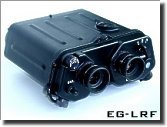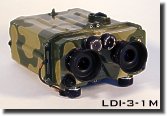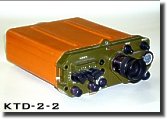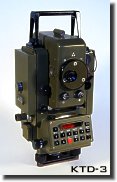
- LASER RANGEFINDERS
POLYUS Research
& Development Institute has
been developing laser rangefinder technology for 25 years. Modern laser
rangefinder technology is indispensable for non-contact and long
distance measurements. To detect signals reflected diffusively from
surface of natural or man-made targets, Q-switched pulsed solid-state
lasers and germanium avalanche photodiodes are used. Now POLYUS
R&DI provides high quality and reliable laser rangefinders of
various types
POLYUS's
Laser Rangefinders Family
|
POLYUS's Laser
Rangefinders have excellent technical performance to meet
professional use in:
 | Topography
& Geodesy
|
 | Marine
Navigation
|
 | Highway
Engineering & Building Construction
|
 | Airborne
Altimeters & Locators
|
 | Traffic
Control
|
 | Meteorology
|
|
|

|
|

|
New POLYUS's
Laser Rangefinders Family is simple in use and operates in
harshest environments. Advantages of eye-safe Er:Glass laser
technology and tacheometry (combination of a laser rangefinder and
electronic precision goniometer) raise great possibilities for new
applications.
|
|
All laser
rangefinders have digital display. Unwanted echoes from nearest
targets and dummy objects due to atmospheric interference (rain,
snow, smoke, etc. ) may be gated by minimum range setting from 50
to 5000 m. Rangefinders provide first/last target selection and
measurement of range to each of them.
|

|
Specifications
|
Model
|
EG-LRF
Eye-Safe Laser Rangefinder
|
LDI-3-1M
Compact Laser Rangefinder
|
KTD-2-2
Topographic Laser Rangefinder
|
|
Laser
|
Er:
Glass
|
Nd:
YAP
|
Nd:
YAP
|
|
Wavelength, µm
|
1.54
|
1.079
|
1.079
|
|
Measurement
Range, m
|
50...25000
|
50...25000
|
100...10000
|
|
Accuracy, m
|
±5.0
|
3.5
|
0.5
|
|
Pulse
Repetition Rate, s-1
|
1/5
|
1/3
|
1/4
|
|
Sight
Magnification
|
x
7.5
|
x
7.5
|
x
7.5
|
|
Operating
Temperature, °C
|
-20...+50
|
-40...+50
|
-40...+50
|
|
Output
Interface
|
RS-232
|
serial-parallel
code
|
|
Power Supply
|
DC,
12 V, Ni - Cd battery
|
|
Dimensions, mm
|
220x200x90
|
75x145x155
|
260x200x90
|
|
Weight, kg
|
1.9
|
1.3
|
2.7
|
LISD-2 Laser
Velocimeter & Rangefinder
Specifications
|
Measurement
speed
|
0
- 200 km/h
|
|
Maximum range
to car
|
400
m
|
|
Measurement
range
|
2
- 999 m
|
|
Range
measurement accuracy
|
±
0.2 m +0.001 L
|
|
Measurement
time
|
0.45
s
|
|
Directional
pattern width
|
0.004
x 0.004 rad
|
|
Field of sight
view
|
6°
|
|
Lifetime
|
5
x 107 cycles
|
|
Interface
|
RS-232
|
|
Power supply:
- 6V, 4 AA battery (1000 measurements at 20 °C)
- external power supply 12 +-2V, 0.2A
|
|
Overall
dimensions
|
210
x 162 x 92 mm
|
|
Weight
|
no
more 1.6 kg
|
|
Operating
temperature range
|
-30...+50
°C
|
|
Safety
standard: LISD-2 Laser Velocimeter & Rangefinder is eye-safe
device and corresponds to Class 1
|
|
|
LISD-2
Laser Velocimeter & Rangefinder also registers a signal miss
or loss, eliminates measurement errors because of jumping to
another vehicle, automatically makes up to 10 repeat measurements
in case of unsuccessful previous ones, has audible signaling
indicative of operation and exceeding a speed limit.
LISD-2 Laser Velocimeter & Rangefinder is designed
as a single unit with a built-in battery. At the front of the
device there is the sight eyepiece with the built-in digital
indicator, the controls, the liquid-crystal display, the mains and
interface plugs. The start button is placed at the top of housing.
The device is provided by shoulder belt or could be set on a
tripod.
|
|
LISD-2
Laser Velocimeter & Rangefinder is joint development of POLYUS
Research & Development Institute and KrasnogorskyPlant and
made by the order and with funds of MKNT Joint-Stock Company of
Moscow Government
|
KTD-3
LASER TACHEOMETER
|

|
The KTD-3
Laser Tacheometer is designed for measurement of angles and
distances at topographic survey, survey of general layouts of
industrial enterprises, in engineer geodesy, at network closeness,
in traversing, etc.
The built-in microcomputer provides solution of various geodetic
tasks, the device checkup and control. Using the KTD-3 Laser
Tacheometer one may determine:
- horizontal angles;
- vertical angles;
- slope distance;
- altitude differences or heights of sighting points;
- coordinate increments of coordinates of sighting points.
|
|
Geodetic
coordinate are computed as corrected for the Earth curvature,
atmospheric refraction, temperature and pressure, height and
coordinates of position points.
|
Specifications
|
Measurement
accuracy (RMS):
- horizontal angles
- vertical angles
- ranges
|
2"
3"
20 cm
|
|
Measured
ranges to diffusely reflecting targets
|
10,000 m
|
|
Rate of
measuring
|
1 measurement
per 4 s
|
|
Wavelength
|
1080 nm
|
|
Telescope
magnification
|
25 x
|
|
Power supply:
DC, 12 V, Ni-Cd battery 2 Ah
|
|
Operating
temperature
|
-40...+50 °C
|
|
Weight
(without battery)
|
8 kg
|
|
|
The
KTD-3 Laser Tacheometer set includes tripod, accumulator battery,
the charge - discharge device, devices for measuring ambient
temperature and atmospheric pressure, accessories for the
tacheometer maintenance.
The information presented on digital display may be
transmitted on an external recorder.
|
|